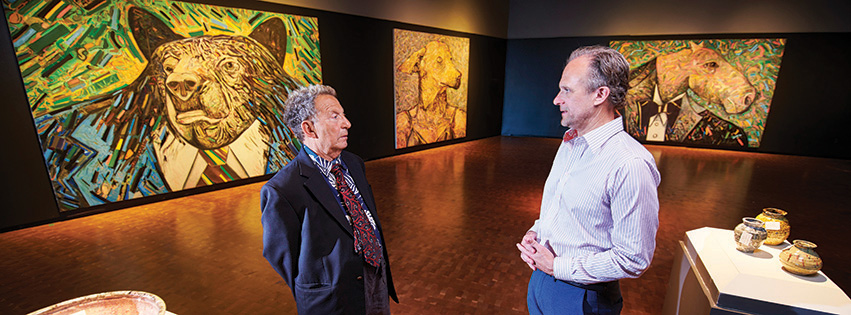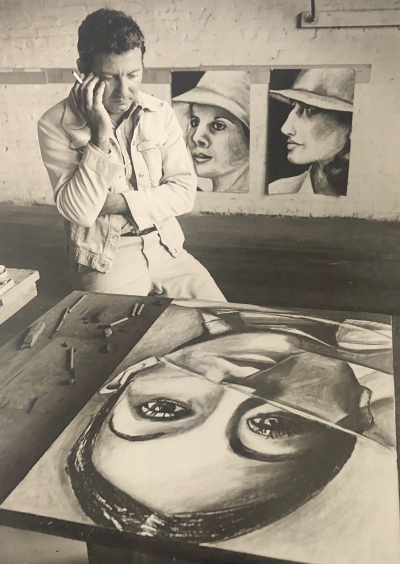The Funk Rages On

As a newcomer to the world of art making, I first met Ken Hoffman in the mid-1980s as part of the old Phoenix Studios’ den of artists then located in Peoria Heights. He became a close friend who would share stories about his own formative art experiences on the West Coast. Connecting those anecdotes to the steady flow of what is now considered to be his classic vernacular—animals in suits—I began to identify some of the source material of these enigmatic images, which are known throughout the Midwest and have been exhibited nationally and internationally. Peoria Riverfront Museum’s exhibition, “Ken Hoffman: 50 Years in Peoria” has become the perfect vehicle to codify and celebrate this extremely important artistic voice.
Making the Artist
In the late 1960s at the Art Institute of San Francisco, Hoffman was developing an artistic voice which would carry him into a half century of examination of the world around him through a unique use of imagery, language and material. The Bay Area art world at that time explored figurative subject matter, experimented with color and finish, and enjoyed an overall playfulness, which set itself apart from the outgoing guard of Modernism. The scene was set into motion by painters like David Park and Elmer Bischoff, who could be found with the musicians in experimental jazz clubs and the Beat writers at City Lights Books. This explosion of creative expression would see the integration of words and rhythmic uses of texture and color in the painters and sculptors who emerged.
The seminal exhibition “FUNK”, held in 1967 at the University of California, Berkeley, established a kind of unwritten manifesto comprised primarily of sculptural works, flamboyant and cartoon-like, with a good dose of psychedelia and surrealism. From this cacophony of quirk emerged artists like Peter Saul and Robert Hudson, with whom Hoffman studied. Through Hudson, Hoffman was encouraged to explore intensity, absurdity and the uncanny. The implementation of these characteristics would become hallmarks of his language.

Although the 1960s movement of Pop Art and its transitional figures, such as Jasper Johns and Robert Rauschenberg, are stated as peripheral to Hoffman, a stunning infiltration of stenciled lettering and Warholian consumerist bottles of Cutty Sark scotch whisky and Chanel perfume can be seen in a portion of a mural completed in 1970 upon the artist’s arrival in Peoria. This salvaged work, now owned by Mary and Andrew Muir and included in our exhibition, is salient and remarkably replete with the hallmark approaches we see in his latest works. Many of these strategies were simply “in the air” of avant-garde art making during this period, and the insertion of text and the collage-layering of found print matter remains notable as it has persisted in his oeuvre over the years.
Mining the Midwest
After securing the position of professor of painting at Bradley University, Hoffman adapted his Bay Area vibe into a pool of more moderate Midwest art—and quickly made waves. After stylistically adopting the portrait by way of fashion-magazine, diva cover shots, he made a slight infusion which prompted a 30-plus year format change of simply replacing the cover girls with assorted animalia in various human attire. Early works would see monkeys in flight goggles, cats in brassieres, and fish in tuxedos. This strategy brought complex anthropomorphic associations from Orwell’s Animal Farm to H.G. Wells’ The Island of Dr. Moreau, which often countered the funk and frivolity. At this expansive point in his career, a multitudinous swell of paintings emerged which mined deeply into this territory.
The most recent sea change in Hoffman’s career has seen a resurgence of the prescient attitudes of those Bay Area years. Continuing to challenge convention, Ken now scours the city streets and river shorelines for objects to receive paint. The traditional oil-on-canvas approach has to an extent yielded to an exploration of how paint—often infused with any substance that it will allow—can transform objects such as cardboard boxes, air conditioning filters, Adirondack chair backs and rubber sandals into a litany of bricolage works which now push into other territories.
Although his ever-present creature portraits remain, they are kept in the good company of still life compositions which incorporate radiant flower patterns, text-infused rants, and yes, those iconic bottles, always painted to strains of jazz or other progressive music oozing through a paint-smeared boombox. The funk rages on as the instincts of Ken’s earliest years re-emerge yet again and spill into a new chapter of production for arguably the region’s most renowned expressionist. PM
Bill Conger is Curator of Collections & Exhibitions at the Peoria Riverfront Museum, where “Ken Hoffman: 50 Years in Peoria” is on display this summer.
- Log in to post comments

